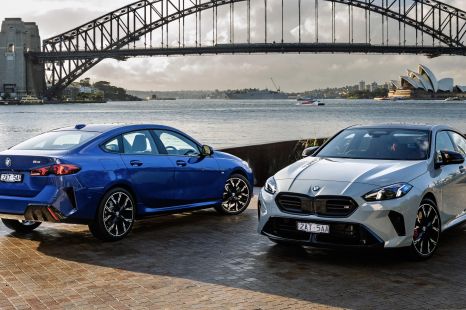

Max Davies
2025 BMW 2 Series Gran Coupe review
4 Months Ago
The Ford Mustang refuses to go out of fashion, and the 2022 line-up is at its most desirable in GT V8 manual guise.
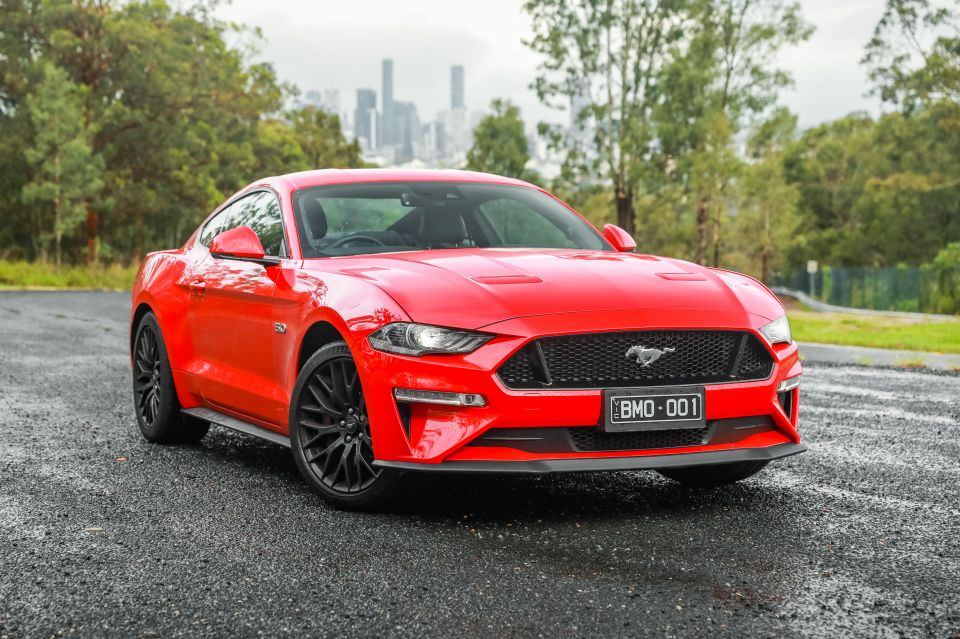
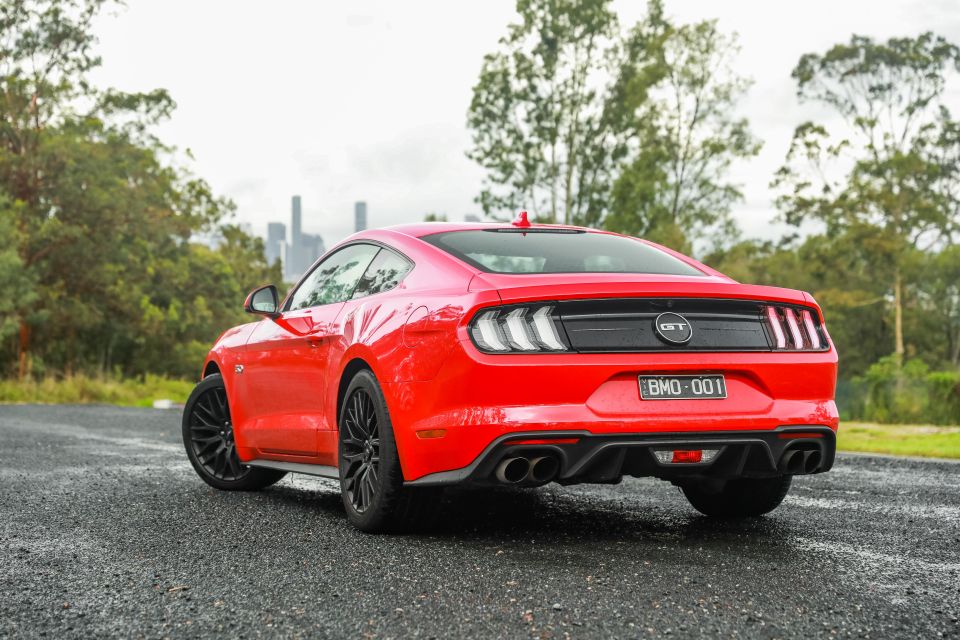

Quickly see how this car stacks up against its competition. Select any benchmark to see more details.
Where expert car reviews meet expert car buying – CarExpert gives you trusted advice, personalised service and real savings on your next new car.
The Ford Mustang is far and away Australia’s best-selling sports car, and helps fill a gap left by the departure of high-performance Ford Falcon and Holden Commodore models.
It’s the combination of an evocative nameplate, unmistakable styling, and an available V8 that fuels the Mustang’s success locally. One can’t underestimate the power of a V8, as the GT far outsells the still quite enjoyable High Performance with its turbocharged four-cylinder engine.
The Mustang’s arrival in 2015 has shown there wasn’t just a pent-up demand bubble of sorts for a pony car, but rather an enduring market for one.

Ford imported a limited number of Mustangs to Australia between 1965 and 1966 and then 2001 and 2002, but this is the first generation the company has truly committed to in Australia – that’s been helped, no doubt, by a more global focus with the current generation that has seen it introduced to markets like Europe.
There’s a reason cars like this are called pony cars: the Mustang effectively invented this segment, although while it originated as a Falcon-based model it long ago stopped platform-sharing and therefore sits on a bespoke platform.
While often referred to as muscle cars locally, that appellation historically applied to a mid-sized vehicle with a high-performance engine, often one borrowed from a larger vehicle. Muscle cars typically didn’t feature unique bodies, unlike pony cars which have always differed from their platform-mates with completely distinct styling, almost always with “long hood, short deck” styling. Those design elements remain very much in effect with the Mustang.
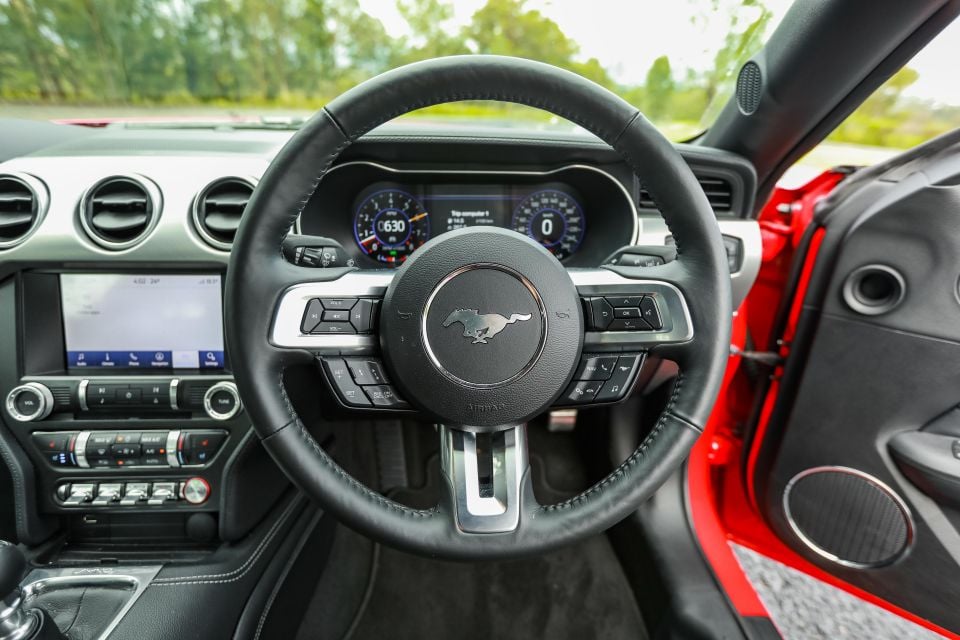
With the discontinuation of the Chevrolet Camaro, a direct rival hamstrung by a much higher price due to its local right-hand drive conversion, the Mustang has no rival pony cars. FCA and now Stellantis have missed a trick in not bringing the Dodge Challenger here which, though not as universally known as the Mustang, would have surely been a success here.
Mustang demand has cooled somewhat – Ford sold a whopping 9165 in 2017, but it’s settled into a groove of around 3000-4000 annual sales.
Those are still astonishing numbers for a coupe, considering in 2021 nothing else in the VFACTS Sports Under $80,000 segment cracked 1000 units – not the Mazda MX-5, not the Subaru BRZ or Toyota 86, and not even the Nissan 370Z that enjoyed a twilight year sales rally. And it’s the GT V8 coupe that’s accounting for the lion’s share of Mustang sales.
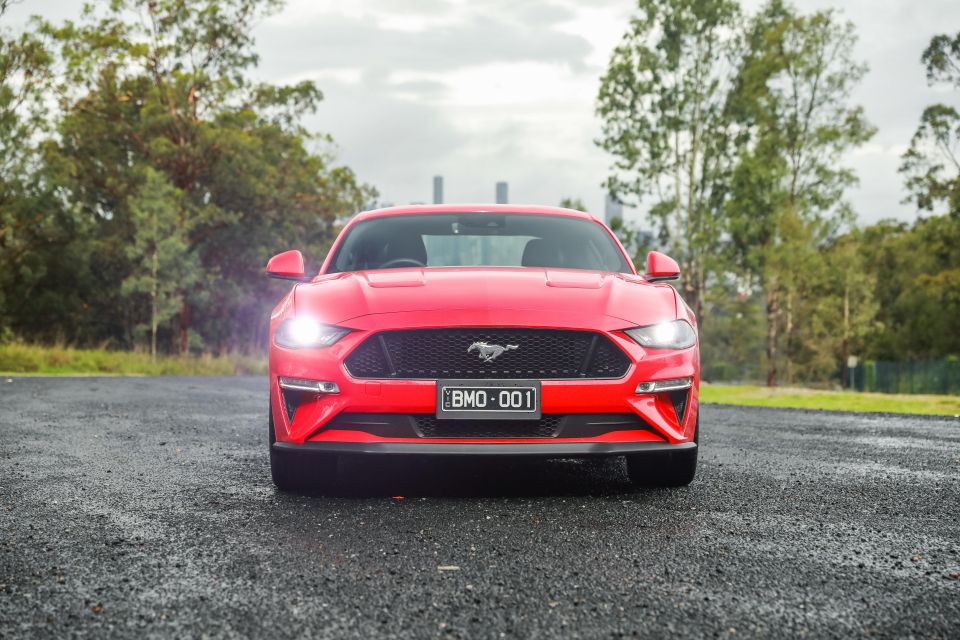
The 2022 Ford Mustang range opens at $52,590 before on-road costs for the base High Performance manual with its turbocharged four-cylinder engine.
Our tester is the V8-powered GT with the standard six-speed manual transmission, the most affordable Mustang with a bent-eight. It’s priced at $65,290 before on-roads, though there’s a new-for-2022 GT California Special available for $67,290 before on-roads.
The optional 10-speed automatic transmission adds $3000 to the cost of either, and is the only transmission available with the convertible body style.

Premium paint is an extra $650, though our tester’s Race Red is a no-cost option.
With no Camaro or Challenger, the Mustang has no direct rivals in Australia but there’s other performance fare at this price point, if not anything with a V8 following the withdrawal of the Chrysler 300 SRT.
High-performance options include the Kia Stinger GT ($63,960 before on-roads), the soon-to-be replaced Nissan 370Z Nismo ($61,990 list). You can’t even get an entry-level German coupe for under $70,000 before on-roads, let alone anything approaching the Mustang GT’s level of performance.
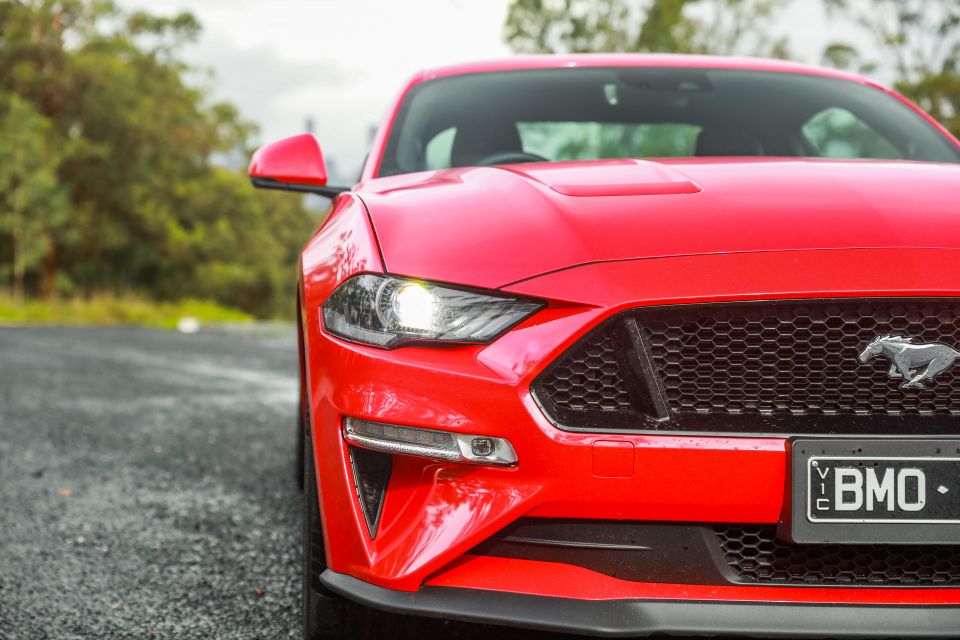

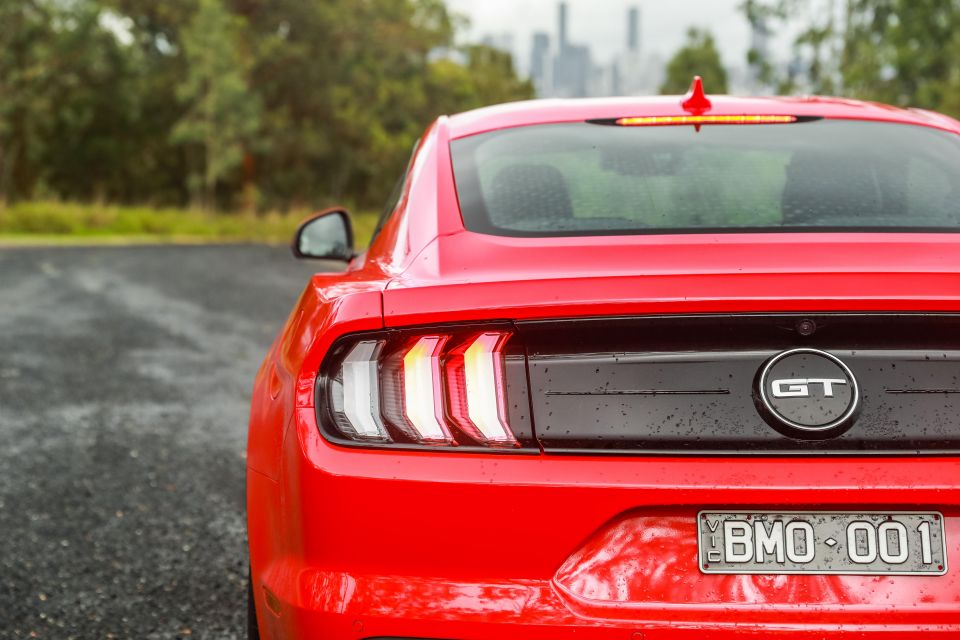
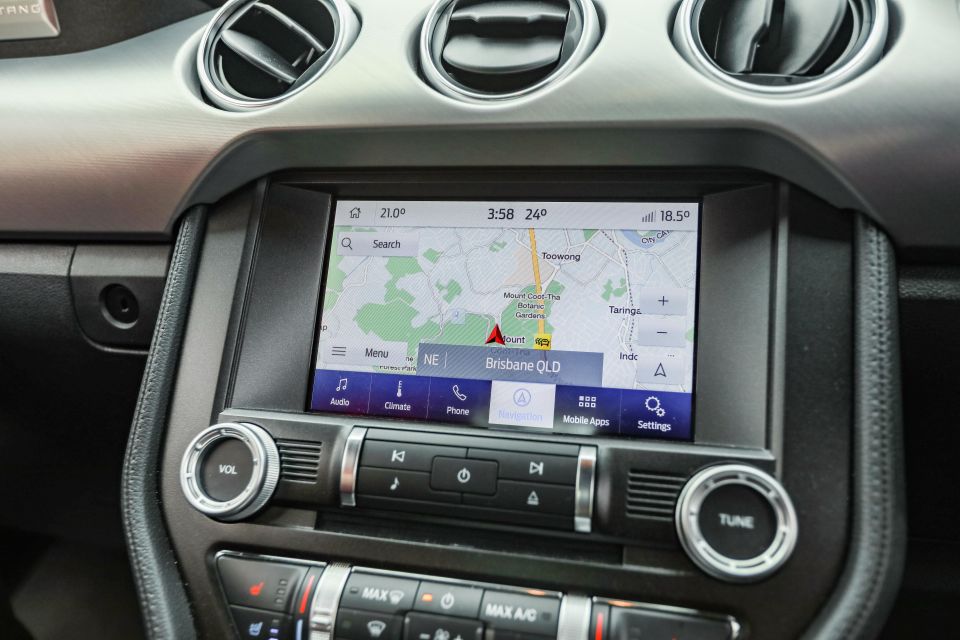
All 2022 Ford Mustang models come standard with the following equipment:
The California Special’s additions are purely aesthetic. It features an exterior appearance package, plus some different trim inside like suede on the seats.
Options on the Mustang GT include Magneride suspension ($2750), Recaro seats ($3000), high-rise rear spoiler ($750) and forged alloy wheels ($2500), while there are also different stripes available.
It’s worth noting model year 2022 Mustangs, due here in the second quarter of 2022, include updated Track Apps software for 2022, which finally enables the Line Lock function for the track. Otherwise, they’re unchanged apart from the colour palette – don’t worry, though, as our tester’s Race Red is still available.
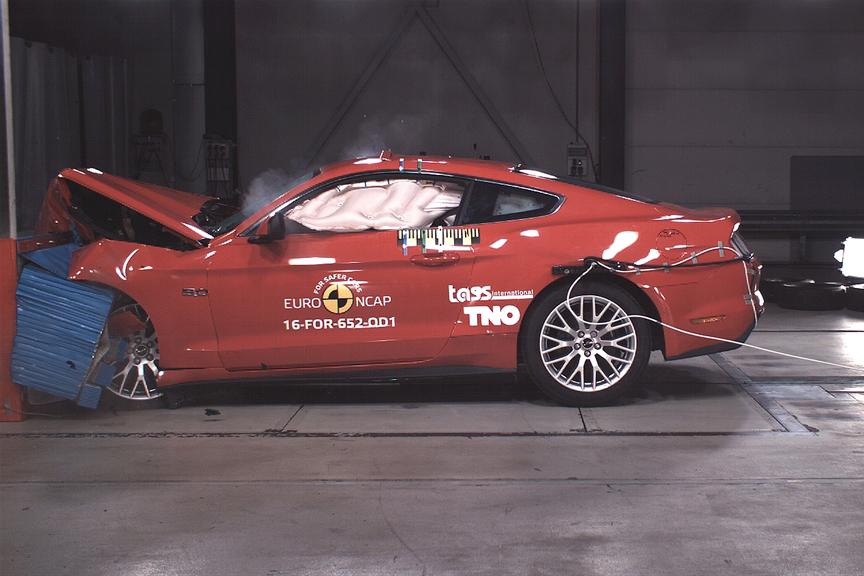
The Ford Mustang wears a mediocre three-star ANCAP safety rating based on tests conducted in 2017.
That rating was based on an adult occupant protection score of 72 per cent, pedestrian protection of 78 per cent, and safety assist of 61 per cent, but it was the child occupant protection score of 32 per cent that really dragged the Mustang down.
While this particular category had various Good and Adequate scores, ANCAP gave head protection for a 10-year dummy a score of ‘Poor’ in the side barrier test. It observed the dummy’s head bottomed out through the side curtain airbag, making contact with the C-pillar trim.

All 2022 Ford Mustang models come standard with the following safety features:
There’s no blind-spot monitoring or rear cross-traffic alert available, even as an option.
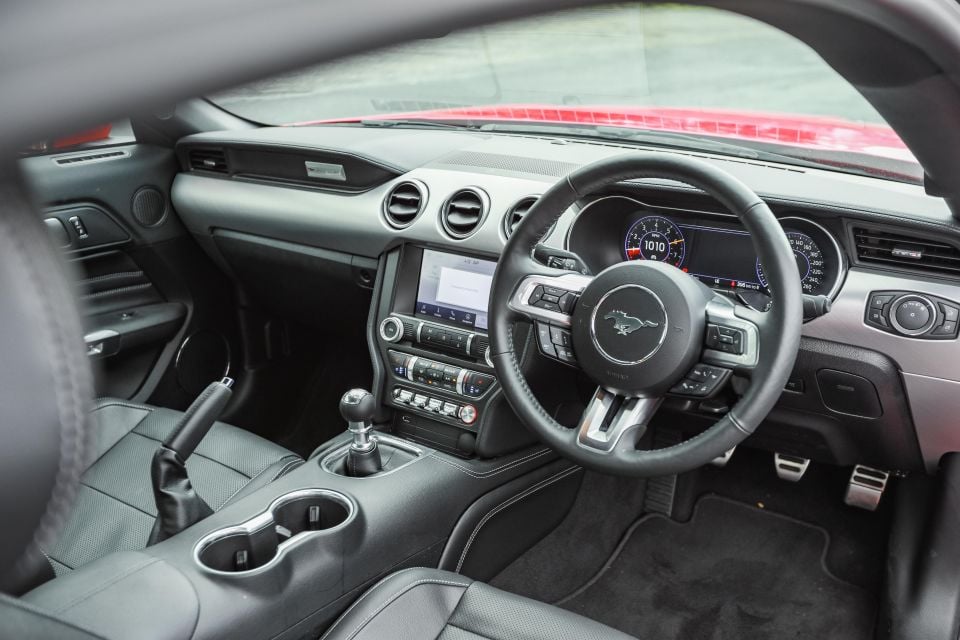
The Mustang’s 2018 facelift really improved the ambience of its cabin, though there are still some naff material choices here and there. We tolerate a lot worse in comparably-priced utes, however, and the Mustang essentially has no direct competition here and therefore nothing to upstage it.
There’s a retro dual-cowl look to the dashboard, with a bluff centre stack headlined by an 8.0-inch touchscreen infotainment system.
Ford’s infotainment remains one of the best on the market in terms of responsiveness and usability. Its navigation graphics are attractive and it supports over-the-air updates. You can also use the voice prompt button on the steering wheel with the native system, for example to input a destination, and it actually works well.
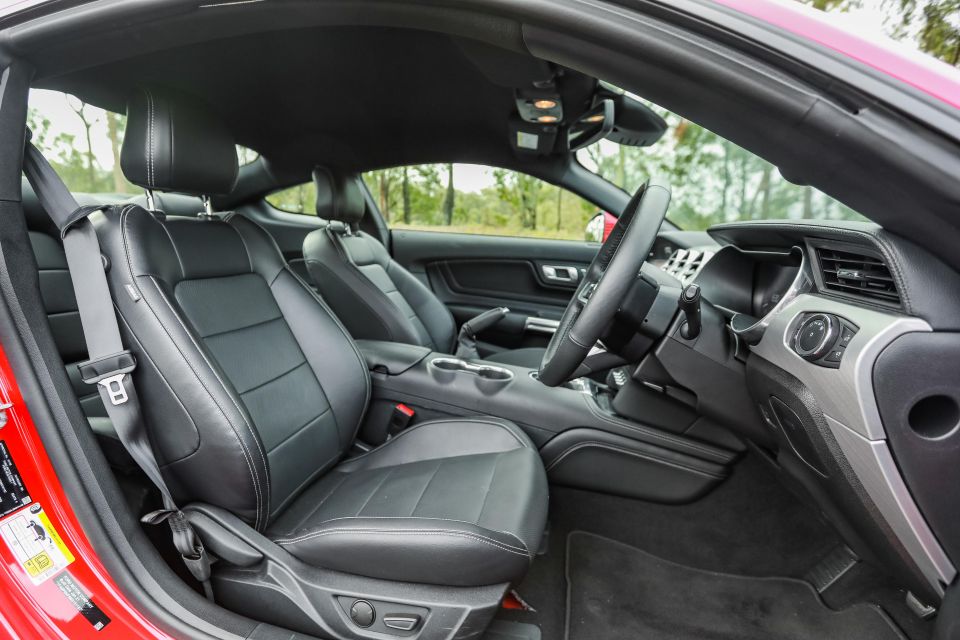
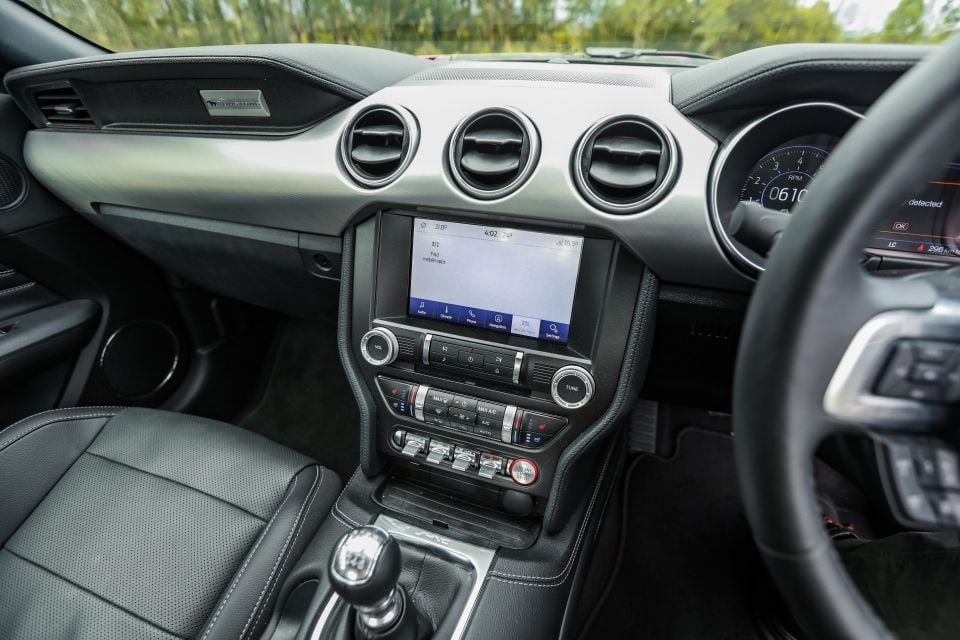
Below the screen are physical switches for the media and climate control, plus a row of retro rocker switches that sound great in theory but are chintzy in execution.
The cheapest-looking parts of the interior are the lighting controls on the roof, which fortunately border a tactile headliner, as well as the power window switch surrounds and the volume and tuning knobs. But there are nice materials in the cabin, too – the soft-touch dash top, for example, or the doors which boast soft-touch tops and leatherette inserts bisected with a band of perforated leather.
There’s soft-touch material on the sides of the centre stack, and the centre console gained stitching with the 2018 facelift and looks much less plasticky though it’s still lacking in storage. The little nook at the base of the stack has a USB-A outlet but no room to keep your phone, though the centre console bin is at least decently-sized and boasts a second USB-A outlet.

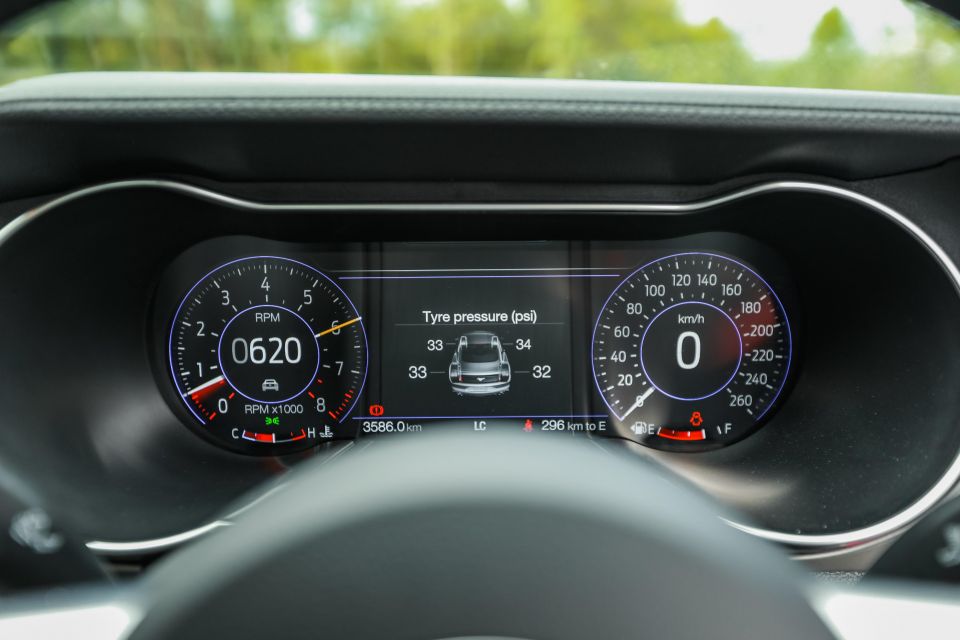
The door pockets are also unusual. They don’t fit anything large, though you can wedge a small bottle in and then push it back into a strange void where you’re guaranteed to forget about it. The glovebox is better, being decently sized if concealed with a rather plasticky lid.
Perhaps the highlight of the Mustang’s interior is the digital instrument cluster, which is attractive, well-integrated and customisable. It doesn’t look like an afterthought and features a variety of different displays, balancing the Mustang’s heritage styling with modern technology and UI. You can either use whichever display is assigned to the selected drive mode, or choose a preferred layout manually.
While the instrument cluster won’t display maps like the Volkswagen Group’s Virtual Cockpit, it will display turn-by-turn directions even when you’re using navigation via smartphone mirroring.
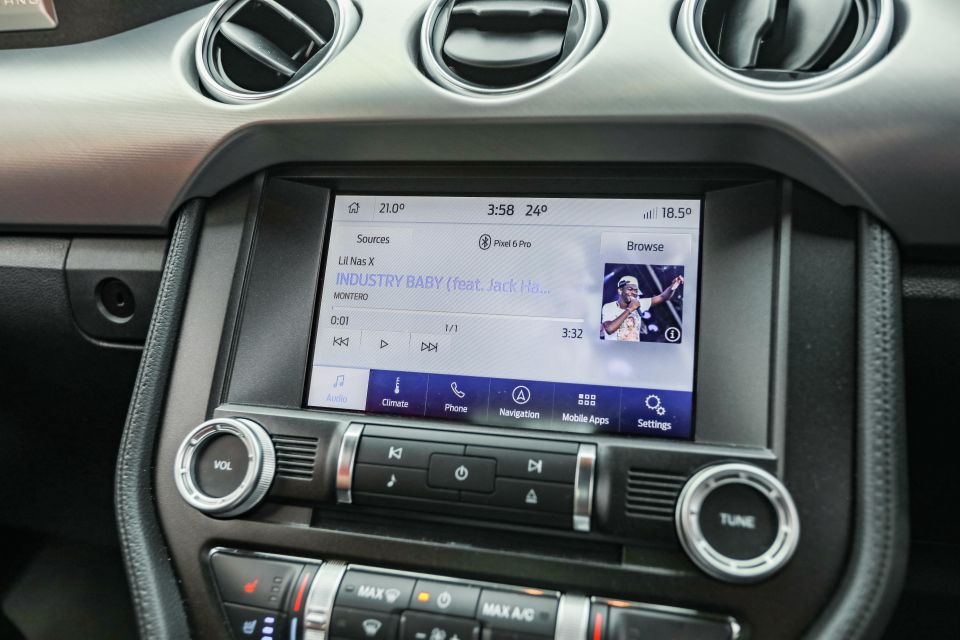

The button on the steering wheel with the Mustang logo takes you to a menu where you can access track apps, adjust the exhaust mode, toggle the performance shift indicator and launch control, and change the colour of the gauges and ambient lighting.
There’s plenty of variety with the colours, allowing you to customise the Mustang’s interior quite nicely. You can also adjust the driver assist systems via the instrument cluster.
The front seats are decently supportive and are both heated and ventilated, though they aren’t fully power adjustable – the seatback must be manually adjusted. The leather doesn’t look as taut as on some cars, and wrinkles a bit. The car does, however, remember your heated/ventilated seat settings upon startup.
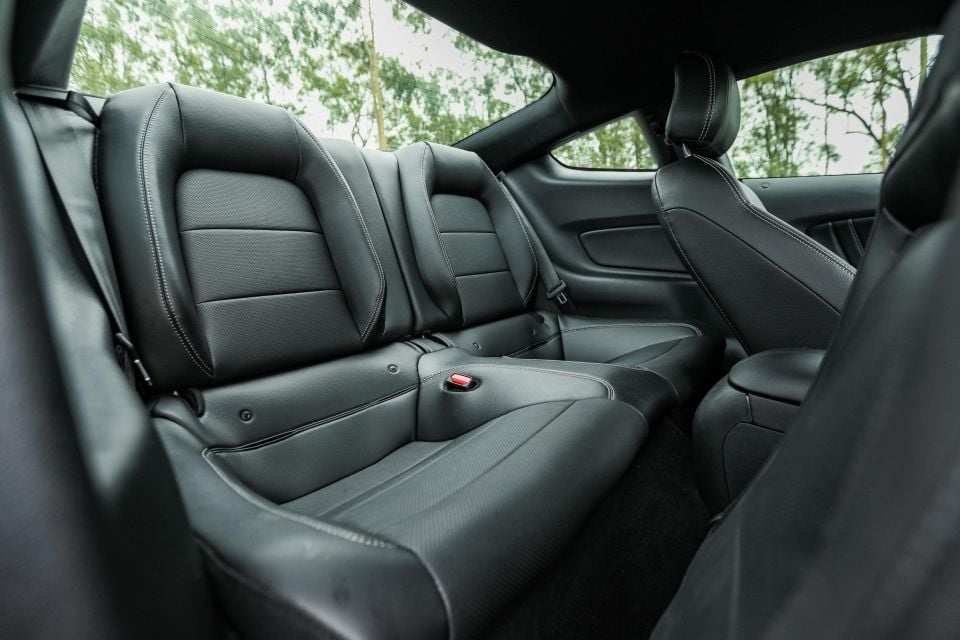
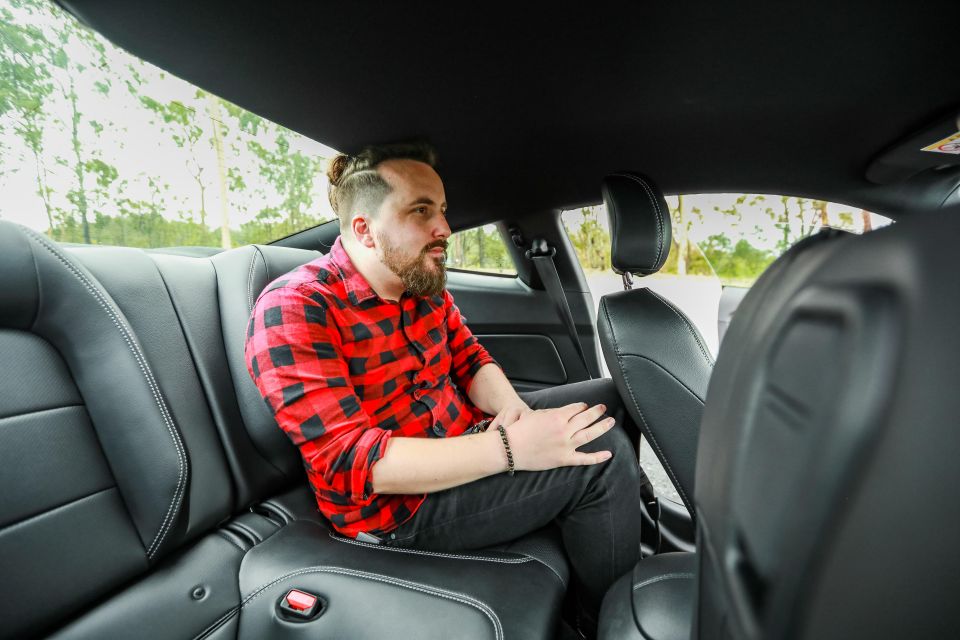
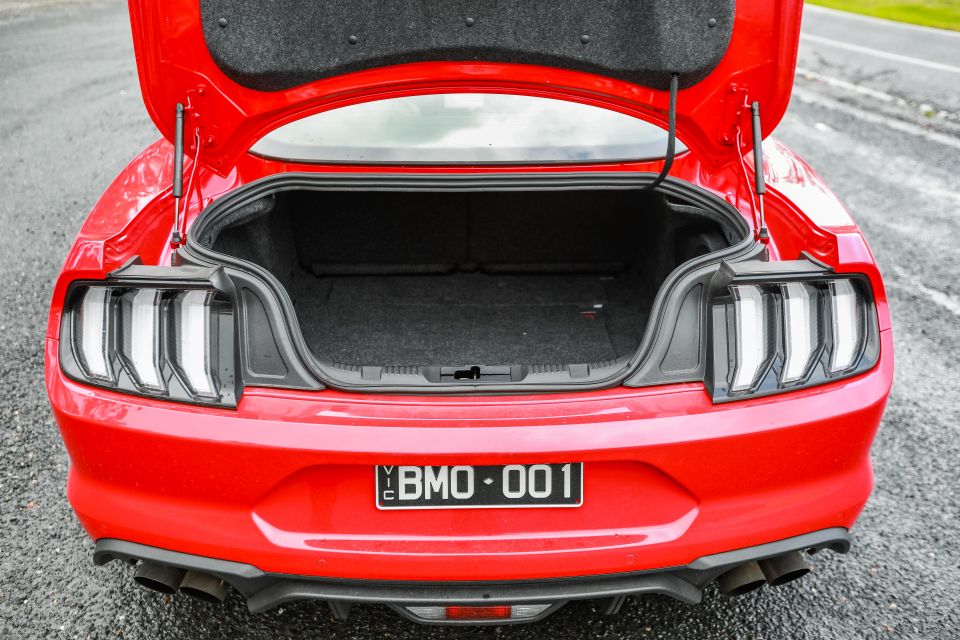
Awkwardly clamber into the back and you’ll quickly regret it, unless you’re eight years old. Legroom is adequate but headroom is diabolically bad due to the Mustang’s steeply raked rear window.
Future Mustang generations could afford to be smaller given there’s no real practical value to this size. No, I’m not calling for a redux of the Pinto-based 1974 Ford Mustang II, but it’s clear the current car is only this big for the sake of its exterior proportions.
The Camaro is just as tight back here, though the two pony cars’ chief rival – the Dodge Challenger – can actually fit adults in its back seat despite similarly retro styling. You can thank an even larger footprint and a more upright roofline for that. Again, what a pity the Challenger isn’t sold here.
Boot space is a decent 408L. The rear seats also fold 50/50 so you can fit longer items.

Where expert car reviews meet expert car buying – CarExpert gives you trusted advice, personalised service and real savings on your next new car.
The Mustang GT and GT California Special use a naturally-aspirated 5.0-litre V8 producing 339kW of power and 556Nm of torque.
Like the four-cylinder High Performance, which is down 103kW and 108Nm, there’s a choice of six-speed manual or 10-speed automatic transmissions.
While its outputs are lower than those of the discontinued Chrysler 300 SRT (350kW/637Nm) and Chevrolet Camaro SS (339kW/617Nm), the Mustang GT blows away the Kia Stinger GT (274kW/510Nm) and Nissan 370Z Nismo (253kW/371Nm).
While Ford Australia doesn’t publish 0-100km/h times, Ford Europe claims the GT manual will hit 100km/h in 4.6 seconds, which makes it 0.3 seconds slower than the auto.
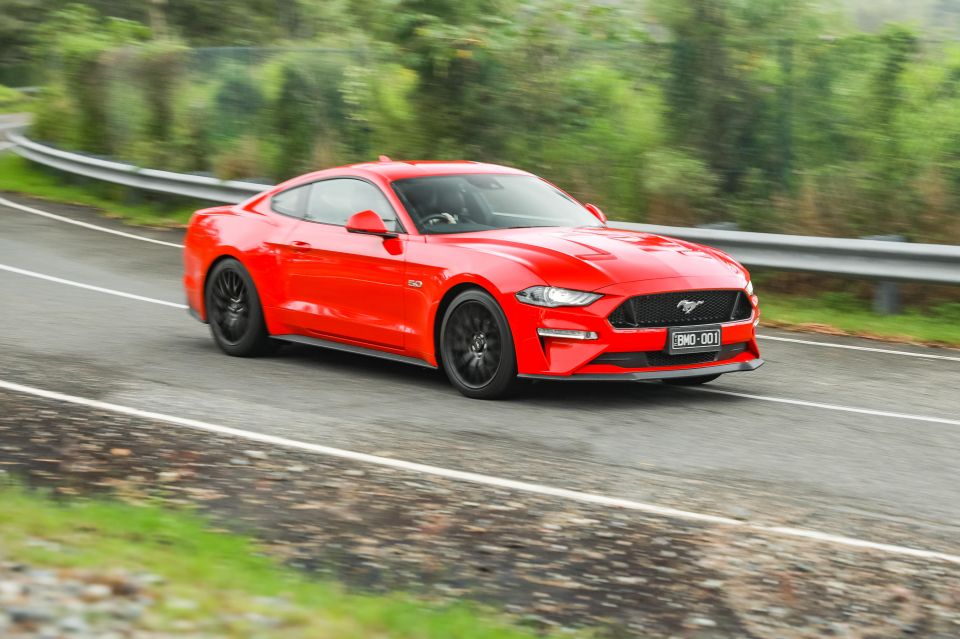
Those pony car proportions impact not only the styling and interior packaging, but also the feel from behind the wheel.
You peer out across a long bonnet, and the Mustang’s shapely hips make it feel wide. That makes corralling this pony a bit of a handful, as there are no front parking sensors and no surround-view camera. The lack of blind-spot monitoring also grates, while the reversing camera is rather washed-out.
The Mustang’s sizeable footprint – it’s wider than a Mazda 6 sedan and only 76mm shorter – means the Ford never truly feels lithe. That’s not to say it feels sloppy, though. Indeed, this tackles corners with aplomb and has a nice, balanced feel, staying flat in corners.
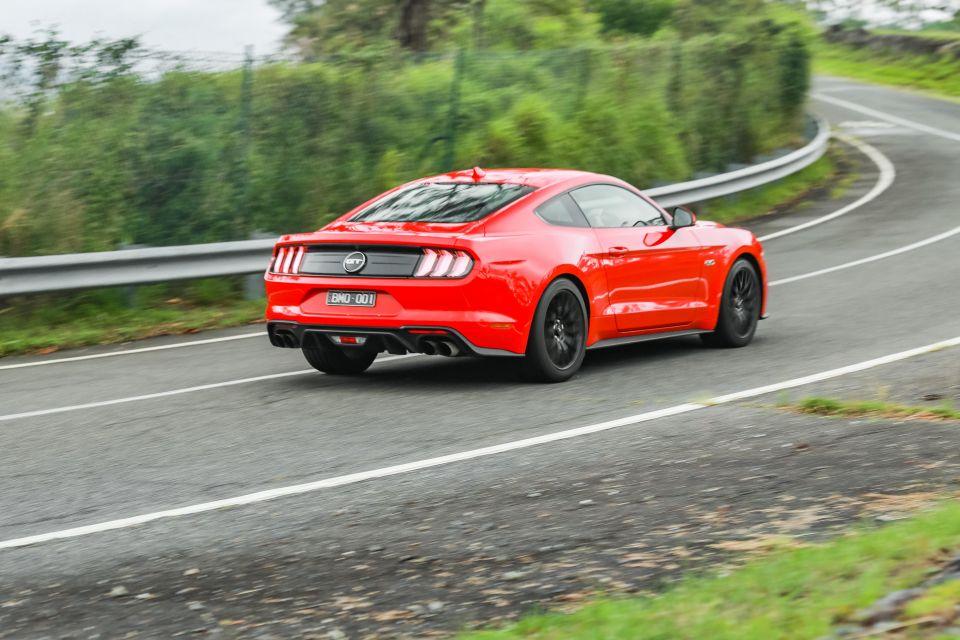
You can forget those memes of Mustangs fishtailing into crowds, with the Michelin Pilot Sport 4S tyres affording great grip. There are no tail-out theatrics here unless you put it in Track mode and really start to push it.
While it feels a bit big and burly on a winding road, the steering and transmission aid driver engagement. The steering is a bit on the heavier side with a satisfying level of road feel, while shift feel is hard to fault – throws aren’t too long, and the shifter never feels too notchy.
It was never going to be as nimble as something like a Toyota 86, but surely it’s a good cruiser, right? Yes and no.
The Mustang has a very firm ride that never truly feels settled. You’ll feel every expansion joint and rut in the road, though sharper impacts are absorbed well enough – it’s busy but neither harsh nor brittle. This is, surprisingly, the first generation of Mustang for which independent rear suspension is standard across the range, so the rear end is at least more tied down than before.

The cabin also gets boomy at high speeds, with tyre roar leaching into the cabin. But if there’s any lack of insulation, that also means the mellifluous V8 can be heard oh so easily inside the car.
Indeed, that engine is sublime, with a strong feeling across the rev range. It also sounds great, and the adjustable exhaust allows you to enjoy it all the more.
You can choose between Normal, Quiet, Sport and Race Track, and these are adjusted not via toggle switches as with the drive mode but, rather, via the instrument cluster, using the MyMode button on the steering wheel.
In Quiet mode, the exhaust pops less on downshifts but still has a satisfying crackle to it. You can also turn off rev-matched downshifts if you don’t want your neighbours to hate you. Turning this feature off (boo!) means it stays off until you activate it again, however the exhaust mode always defaults to Normal on startup.
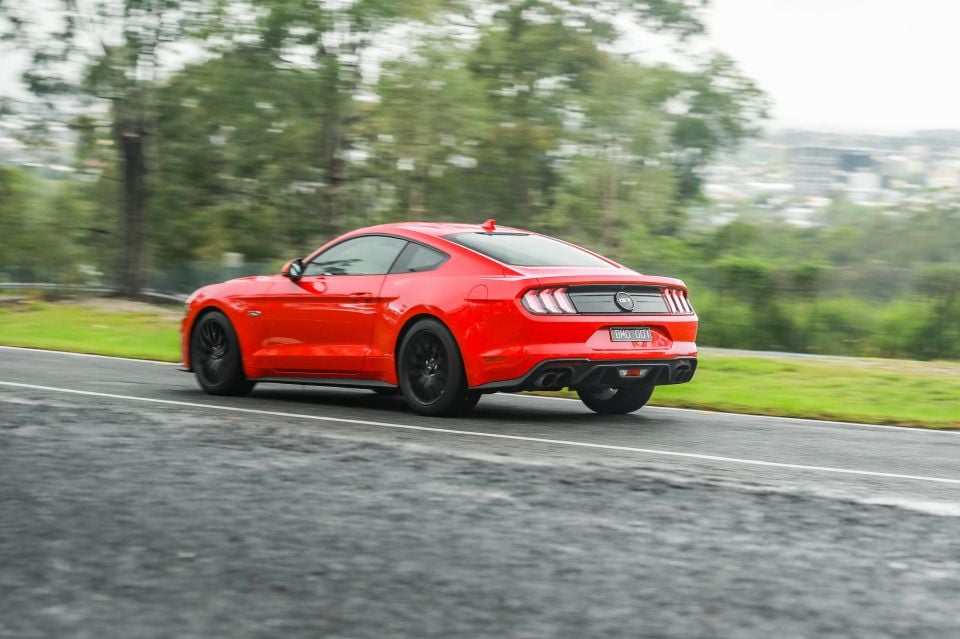
In addition to toggling between exhaust modes, you can also change the display mode for the digital instrument cluster and toggle the performance shift indicator. This works like a progress bar, going from green to yellow then red to indicate when to shift. Given how entertaining and sonorous this engine is, you may be seeing red…
You can choose between Normal, Comfort and Sport modes for the steering, though there isn’t a massive difference between these on the road. In terms of drive modes, there’s Snow/Wet, Normal, Sport+, Track and Drag Strip.
None of the drive modes alter the suspension characteristics unless you spring for the $2750 Magneride suspension option, which features dampers that are full of magnetorheological fluid. An American-developed technology that first appeared on the 2002 Cadillac Seville and has since been used on everything from HSVs to Ferraris, Magneride promises a better blend of ride comfort and roadholding. We’d be tempted to tick this option box, if only for the impact it would have on the ride.
Though it rides firmly with the standard suspension set-up, the Mustang makes a decent case for itself as a daily driver. The shifter falls comfortably to hand and shifts have a nice meaty feel, while the clutch pedal feels just right. At idle, you can feel the brawny V8 throbbing through the shifter, but it’s overall quite a smooth engine.
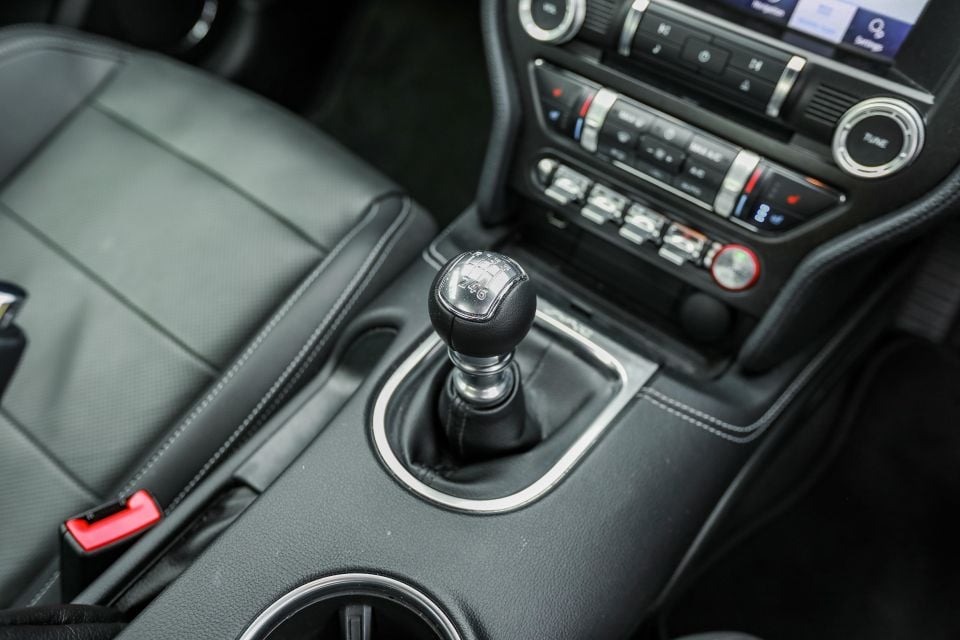
The best part is you don’t miss out on adaptive cruise control by opting for the manual. The optional 10-speed automatic might be a bit easier on your left knee but, while it’s a decent unit, it has a habit of shuffling a bit too much through the gears. You’re buying an old-school, atmo V8-powered pony car, why not just get the manual?
While the adaptive cruise control worked well, the lane-keep assist was unobtrusive to the point of being hard to notice.
Everybody wants to criticise the four-cylinder Mustang and anybody who would deign buy a “phony” Mustang like it, but the High Performance’s turbocharged 2.3-litre four-cylinder is nothing to scoff at. Let’s not forget, either, that Ford put uninspiring naturally-aspirated four- and six-cylinder engines in the Mustang for literally decades.
Slightly less weight over the front axle means the Mustang High Performance feels more nimble and it’s still quite rapid to boot, though naturally this boosted four doesn’t sound as good as a V8.
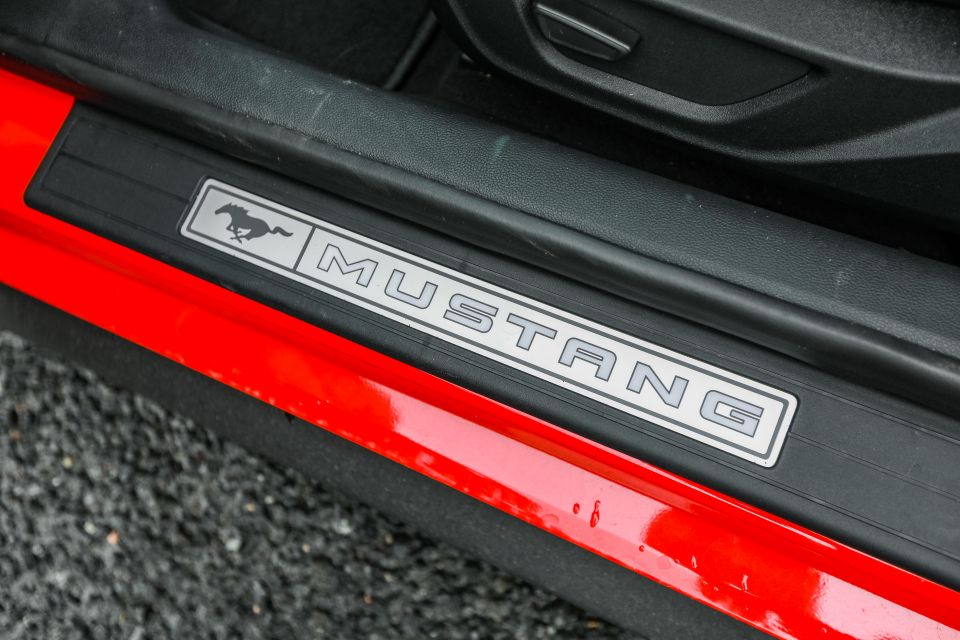
In addition to a five-year, unlimited-kilometre warranty, Ford offers capped price servicing for four years or 60,000km. Each of these services costs $299.
All 2022 Ford Mustang models require servicing every 12 months or 15,000km, whichever comes first.
Over a loop comprising inner-city, suburban and highway driving, we averaged 14L/100km in the GT. Over the course of a week, this increased to 14.8L/100km. The official claim is 13L/100km, or 0.3L/100km more than the GT auto.
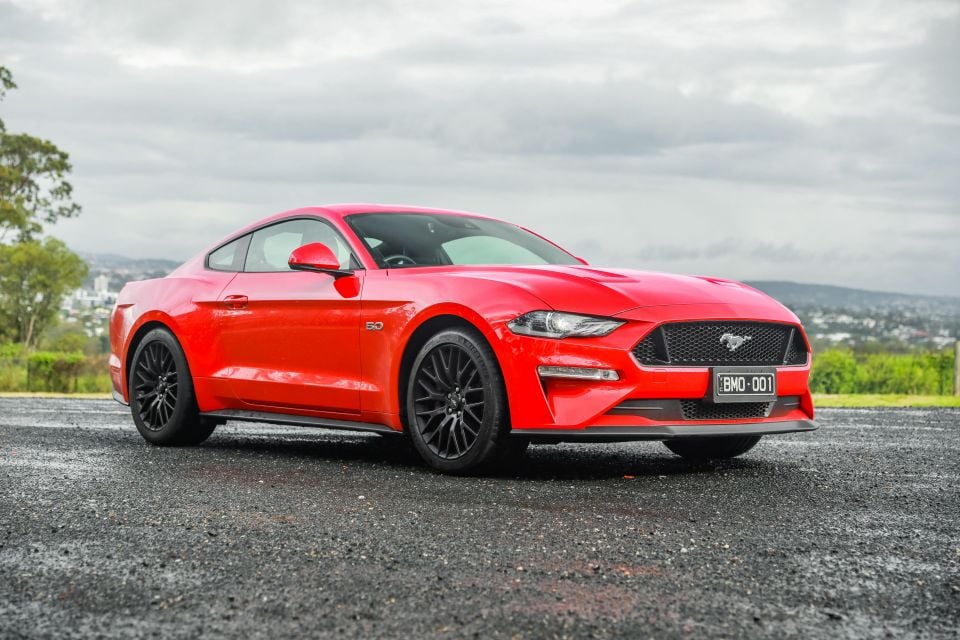
The Mustang isn’t quite a corner carver but not quite a cruiser, and yet it does a good enough job at both. There’s a level of polish here that might surprise you for a pony car.
Firm ride aside, it’s actually quite pleasant as a daily driver with its well-calibrated shifter, clutch pedal and steering, the latter offering levels of adjustment. While fuel consumption is unsurprisingly high, the engine is smooth, flexible, and sounds fantastic. The infotainment and instrument cluster are fantastic, and the front of the cabin is a comfortable place to be.
It’s not perfect. A three-star ANCAP safety rating is disappointing, dragged down by a subpar score for child occupant protection score. Children are about the only people that can comfortably fit in the back seat, which reveals the Mustang’s packaging is a triumph of style over substance.

The absence of front parking sensors, blind-spot monitoring and rear cross-traffic alert is disappointing, although the level of comfort and convenience equipment on offer is impressive.
Still, the Mustang doesn’t have any direct rivals to shame it. There is simply nothing else available in the Australian new car market that offers anything like the Mustang’s style or V8 performance for similar money.
For my money, I wouldn’t bother with the 10-speed automatic or the California Special appearance package – the manual is hard to fault. I’d suggest a drive back-to-back with a GT equipped with the Magneride suspension, which may just be the one extra expense worth recommending.

Click the images for the full gallery
MORE: Everything Ford Mustang
Where expert car reviews meet expert car buying – CarExpert gives you trusted advice, personalised service and real savings on your next new car.
William Stopford is an automotive journalist based in Brisbane, Australia. William is a Business/Journalism graduate from the Queensland University of Technology who loves to travel, briefly lived in the US, and has a particular interest in the American car industry.


Max Davies
4 Months Ago


William Stopford
2 Months Ago
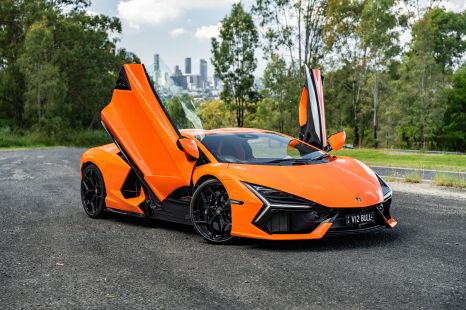

Alborz Fallah
1 Month Ago


James Wong
1 Month Ago


Paul Maric
21 Days Ago


Matt Campbell
12 Days Ago